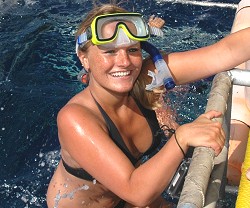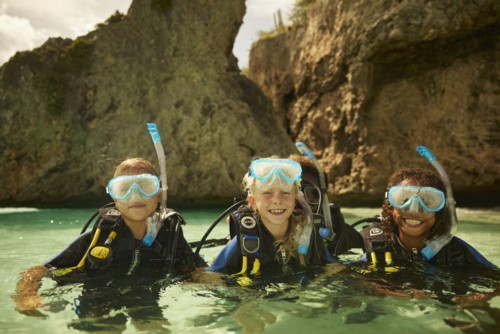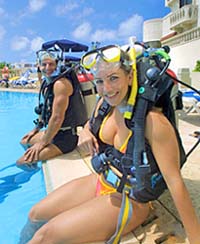

 Online Scuba Lessons |
 Online Nitrox Lessons |
Mask On,
Mask Off...



Ever since I learned to scuba dive, I've heard
Scuba Instructors and Dive Masters tell their students, "Don't put
your mask on your forehead."
These answers are all basically true. As my students know, I tell them to put the mask around their neck when its not on their face because there is where I want them to put it. A good idea, but does it meet the real need – that of training better, more confident and safer divers?
As an Instructor, I am constantly faced with this issue of mask placement while not on the diver's face. In nearly all the cases in which a student is told to put his mask around his neck, he asks, "Why?" I've always had trouble answering this question with an answer that makes good logical sense to a scuba beginner.
Magazines, photos, underwater movies and films (like the old Sea Hunt, and the brief series Sea Quest) continue to show examples of the mask, and other equipment, in the wrong place or poorly attached. And then, as if improper mask placement isn't enough, the movies glorify bad habits and give the viewer a false reality of diving. For example, remember the "Liquid Oxygen Suit" from the Abyss where the star of the movie could dive 5 miles deep and it wouldn't hurt him? While its true that the liquid oxygen reduces the pressure effects, we all know that oxygen is toxic, it will kill you, at 297 feet of sea water. And that's AIR! This was liquid Oxygen (100%)! But then, that's Hollywood. How do I compete?
So what's the Big Deal? Well, it might be bigger than you might first think. I've noticed that when a student is uncomfortable in the water, his or her first move, near or at the surface, is to remove the mask. I have found that removing the mask and placing it anywhere other than around the neck is a certain sign of stress. In fact, students that remove their mask every time at the surface will have a tendency to remove it underwater when under stress - which leads itself to removal of the mask every time something goes wrong, even if the mask has nothing to do with the problem.

During the past 30 years of teaching Scuba Diving, I have noticed a very interesting phenomenon. About 85% of the student who bolted to the surface, for whatever reason, removed their mask prior to reaching the surface, or left it at the bottom. Guess what, they're the same ones that insisted on wearing the mask on their forehead. Conversely, students who did not remove their mask every time they were at the surface and when doing so, placed it around their neck, had a greater tendency to leave the mask on during underwater difficulties. In addition to that, students who were comfortable wearing the mask around their neck, performed all skills better, including mask clearing, with almost zero bolting attempts.
Conclusion: Divers who wear their mask on their forehead and insist on removing it every time at the surface have a tendency to have lesser skills and higher possibility of accident and/or injury. Therefore, Instructors and Dive Masters are trained to watch for this action...
Don't be labeled a beginner, where your mask on your neck when it's not on your face!!
Dive Safe and dive often,
Bwana
![]()

Aquastrophics Dive & Travel
(928) 680 - DIVE (3483)